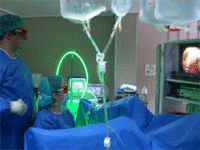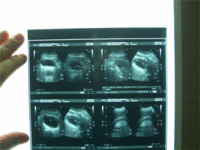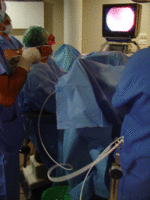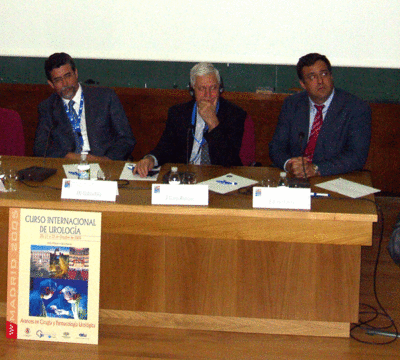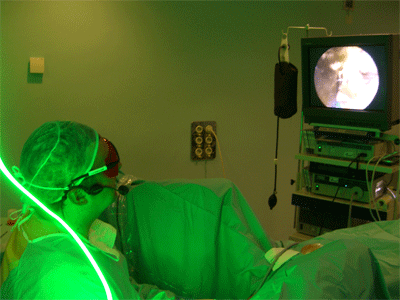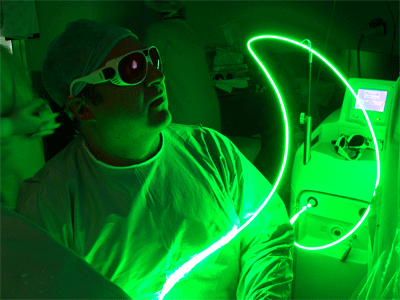

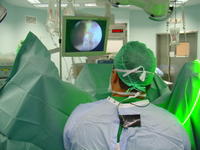
The Vasc Urological Society invited me to participate in the 10th live surgery meeting of this society. There I operated a patient with Benign Prostatic Hyperplasia with a High Power (80 Watt) KTP laser. The meeting had two theatres prepared for live surgery. I was operating and Dr. Richard Gaston, maybe one of the best urological laparoscopists in the world, performed a radical cystectomy for bladder cancersimultaneously in the contiguous theatre.

This is a view of the theatre where I performed the operation. The cameraman filmed the outside view, and another camera filmed the endoscopic view, both were transmitted to the congress room.
I had a microphone so I cound talk with the moderator of the live surgical session, Dr. Valdivia.
During the operation we had a conversation on the advantages of PVP (Photoselective vaporization of the prostate) in comparison with traditional TURP (transurethral resection of the prostate) and open surgery.
From time to time the conection was sent to Prof. Gaston's theatre, altough the attending urologists were able to see the endoscopic image in a small frame in the screen.
I was lucky, because the patient had a 50 gram prostate, so I managed to complete the operation in about 70 minutes. I tend to be as agressive as I can in removing hyperplastic tissue, because I believe this will provide the longest lasting possible result to my patients.
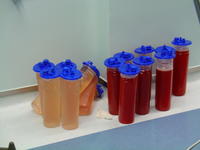
The patient did not bleed at all during the procedure. Right after I finished, another surgeon was in charge of performing a TURP with a plasmakinetic energy generator, a sophistication of traditional TURP. It did not change my mind, KTP laser prostatectomy is much safer and allows a quicker recovery of the patient. If you look at the image, the left irrigation bags (with clear irrigaiton fluid inside) were used during the KTP laser prostatectomy, the right ones were used to irrigate the plasmakinetic TURP. I think this photograph is self-explanatory.

This is the urine bag of the patient after the operation. I left a bladder catheter for 5-6 hours after the operation, because it was performed under spinal anaesthetic, and this can paralize the bladder temporarily. After that short period of time it can be removed and if the patient voids normally, he can go home. As there is virtually no blood loss during the operation, there is no postoperative anaemia, and patients feel great. They can go back to normal life and even to work in two or three days.
Vitoria is a beautiful city, with a very surprising old part of the city. I was able to visit the cathedral that is being refurbished, but it is not closed, because they want to show tourists the discoveries they did when they started excavating. In the entrance there is a sign that reads "open due to refurbishing", very interesting.
Vasc urologists are very good, and also very nice and friendly. I will also take with me the good memories of the vasc cuisine.
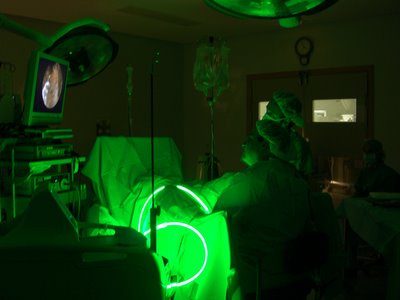
 We also realised that irrigation can be improved with a suprapubic 5 mm laparoscopy trocar. I did not carry with me the Reuter trocar I use in these difficult cases (it is getting more difficult to get it into an aeroplane - it is a sharp metallic object). So this was a good idea, nowadays all hospitals have laparoscopy trocars. This enhances irrigation, the vision gets very clear and it is very useful to operate big prostates with a very small risk and good results. The patient gets a 5 mm wound in his lower abdomen, that is not much of a problem at all. I took the plane back to Madrid, we have a Bank Holiday and tomorrow I will get a chance to rest for a while. I have to return to Valencia this thursday to participate in another rather difficult case.
We also realised that irrigation can be improved with a suprapubic 5 mm laparoscopy trocar. I did not carry with me the Reuter trocar I use in these difficult cases (it is getting more difficult to get it into an aeroplane - it is a sharp metallic object). So this was a good idea, nowadays all hospitals have laparoscopy trocars. This enhances irrigation, the vision gets very clear and it is very useful to operate big prostates with a very small risk and good results. The patient gets a 5 mm wound in his lower abdomen, that is not much of a problem at all. I took the plane back to Madrid, we have a Bank Holiday and tomorrow I will get a chance to rest for a while. I have to return to Valencia this thursday to participate in another rather difficult case.


